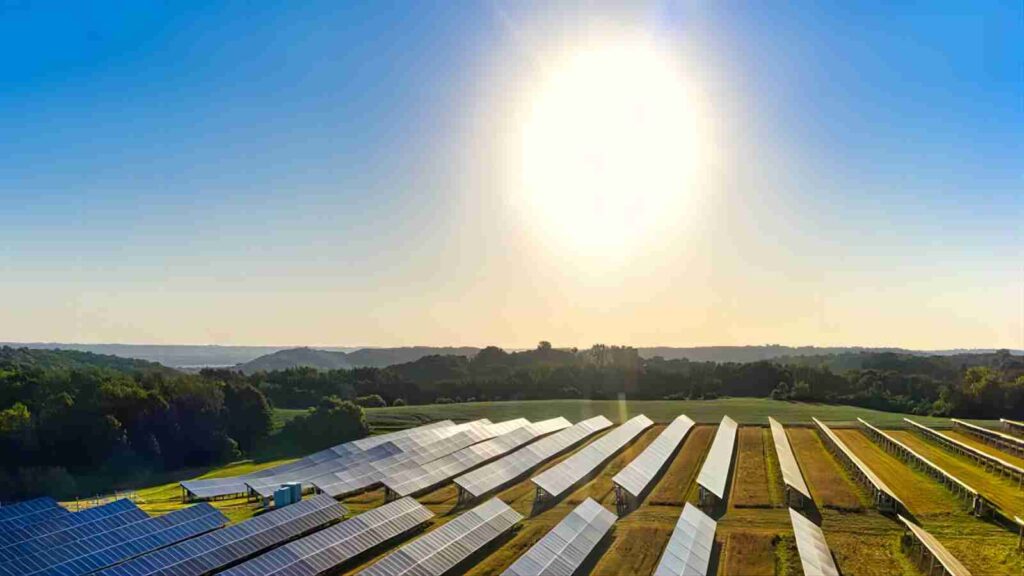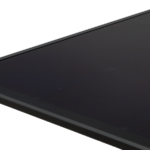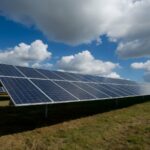Table of Contents
Perhaps you haven’t considered that solar panels may give rise to glare issues, despite their intended design of sunlight absorption rather than sunlight reflection. Solar panels can efficiently absorb vertically incident light, but they are prone to generating glare pollution when sunlight is at a low angle. Opting for inexpensive solar panels and uncertified installers might lead to slight glare from your panels, potentially causing inconvenience to residents and communities, especially when installed extensively in solar power plants. Will your panels disturb your neighbors or attract undue attention? In this article, we will delve into a more comprehensive understanding of solar panels and their reflections, as well as introduce some solar panel technologies aimed at reducing glare pollution.
Why do Solar Panels Create Glare Light?
“Glare light” refers to excessive brightness or intensity of light that can cause visual discomfort or even impairment. Glare is characterized by its ability to reduce the visibility of objects and create discomfort or distraction for the observer. It often occurs when there is a significant contrast between the bright light source and the surrounding environment.
The type of solar cell is closely related to glare. It’s crucial to recognize that photovoltaic (PV) cells vary in their light absorption capabilities. Monocrystalline silicon cells, for instance, excel at absorbing sunlight, making them a preferred choice for high-end solar panels. However, even the most efficient PV cells can only achieve about 80% absorption efficiency, with the remaining sunlight being reflected back as photons.
Reflective surfaces are also a significant cause of glare. Solar panels often have reflective glass surfaces and PV ribbons, when sunlight hits these glass surfaces and PV ribbons, it can be reflected, leading to glare.
Mounting angle relates closely to glare. Firstly, the lower the angle of the sun, the more likely it is for photons to strike reflective surfaces, causing glare. Secondly, the lower the sun’s angle, the more direct sunlight the panels receive. Therefore, if you live in an area with direct sunlight exposure, you might need to tilt the panels away from areas where people gather, in order to minimize the amount of reflected light.
The surrounding environment can influence glare. For example, if solar panels are installed in areas with highly reflective surfaces or near water bodies, the potential for glare may be higher.
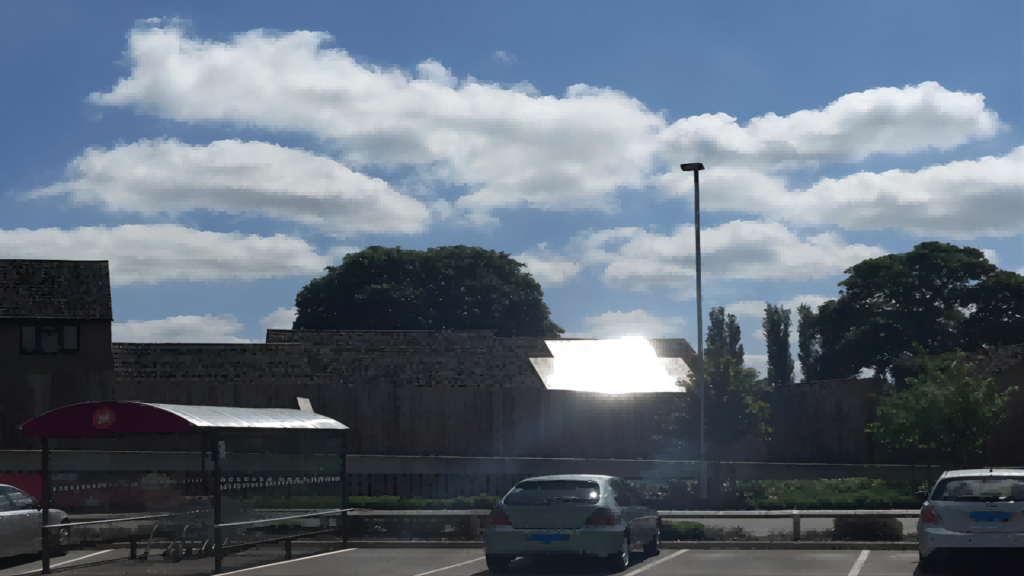
What Kind of Solar Installation Scenarios Require Special Consideration for the Effects of Glare?
Several solar power plant installation scenarios require special consideration for the effects of glare due to their potential impact on surrounding environments, safety, and aesthetics. These scenarios include:
Airports:
Solar power plants located near airports pose a potential risk if glare interferes with pilot visibility during takeoff or landing. Consideration of glare effects and coordination with aviation authorities are crucial to ensure safety in these situations. In this case, it is important to keep the solar panels installed at a certain distance from the airport and pay attention to the angle and direction of the installation, so as to avoid glare affecting the flight safety of the aircraft.
There are Some Regulations Related to Airport Scenario for Installing Solar Panels:
Airport regulations often necessitate solar farms to implement measures for glare reduction. In the United States, the Federal Aviation Administration (FAA) imposes regulations to prevent potential glare-induced blindness for pilots caused by solar panel reflections. Compliance with these regulations mandates that solar farms maintain a distance of at least five miles from an airport and utilize specialized low-glare photovoltaic (PV) cells.
In Australia, when evaluating the feasibility of a solar installation near an airport, the Civil Aviation Safety Authority (CASA) typically aligns with guidance from the FAA. Solar panels are primarily designed for light absorption, minimizing reflection. The FAA recommends conducting a glare analysis for any solar farm positioned along the runway alignment and within 2 nautical miles of the runway end.
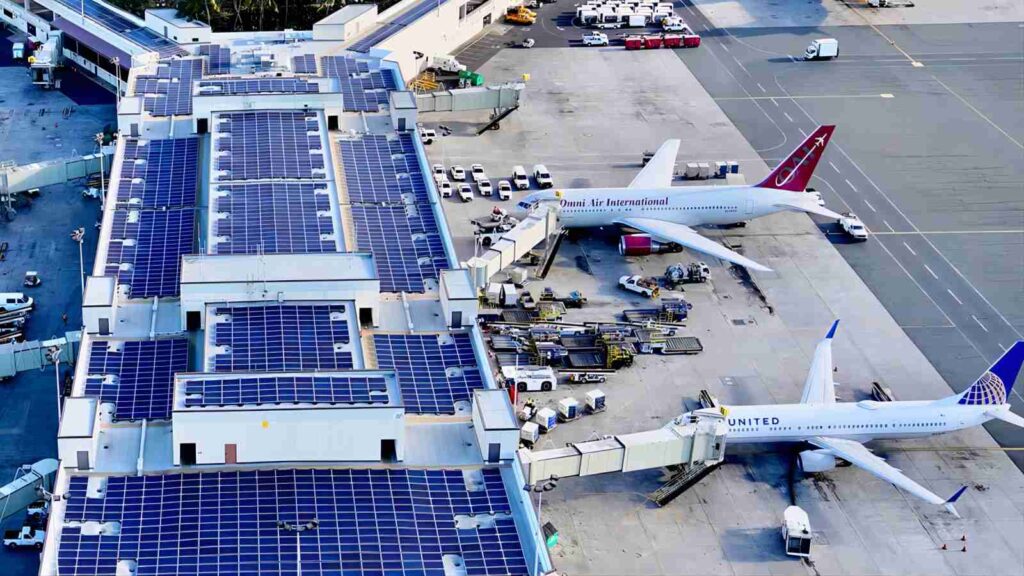
Highways
Solar power plants located near highways, busy roads, or areas with high vehicular traffic require special consideration. Glare from solar panels can potentially distract drivers, leading to safety concerns. Proper positioning and glare mitigation measures are essential in these scenarios. When planning the location of solar panel installations, consider their relative position to the motorway. Choose a location some distance from the motorway to reduce the possibility of glare hitting the driver’s eyes directly.
Residential Roof Areas and Urban Settings:
Installation of solar panels in residential or urban environments, such as areas of high pedestrian activity (e.g. parks or recreational areas), as well as on residential rooftops also requires particular attention to the effects of glare. In order to avoid the glare from solar panels affecting others, we need to choose low-glare solar panels and find the right installation location and installation angle to minimise the glare impact. Below is a picture of a netizen describing a conflict with his neighbour caused by the glare of solar panels.
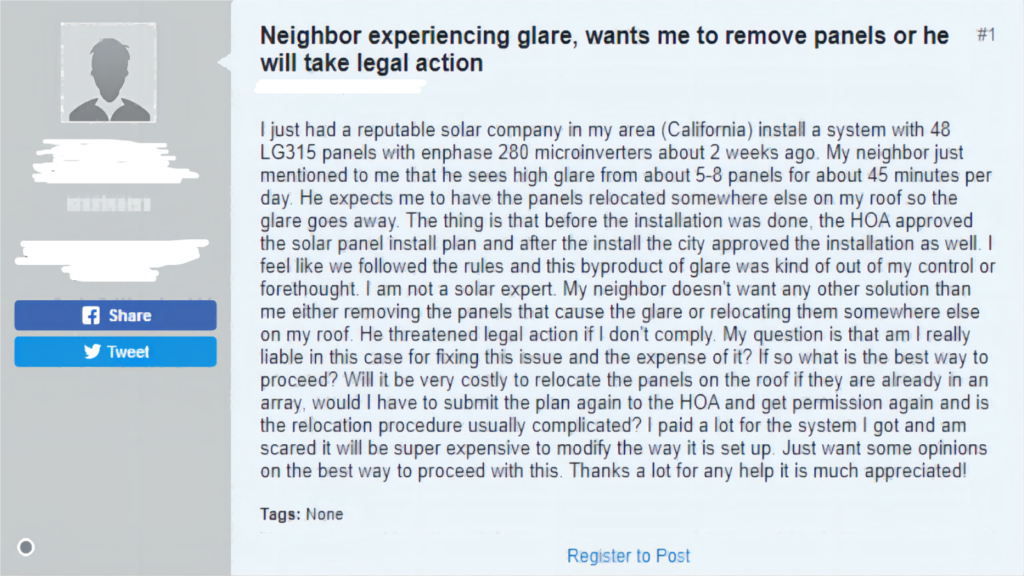
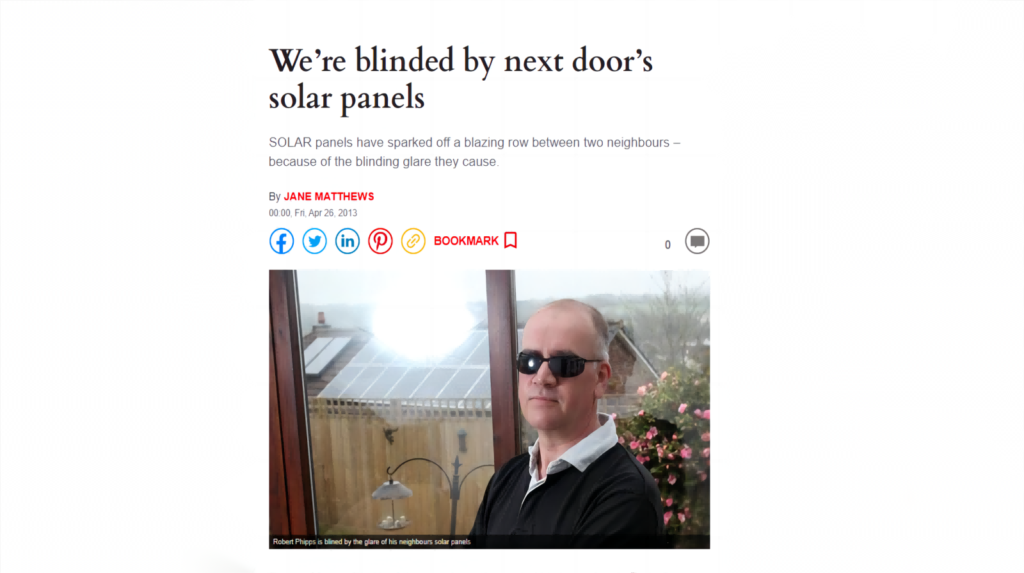
Below is an article told by a certain glare victim about the adverse effects of glare from solar panels installed by his neighbours:
https://www.express.co.uk/news/uk/394812/We-re-blinded-by-next-door-s-solar-panels
Natural Scenic Areas and Water Bodies:
When installing solar panels near natural habitats, tourist attractions, or water bodies, it is crucial to consider potential impacts on wildlife, scenic beauty, and glare from sunlight reflecting off water. To mitigate these effects, choose installation locations that minimize disruption to wildlife and integrate visually with the surroundings. Implement glare reduction measures, such as selecting non-glare solar panels, adjusting installation angles, and incorporating low-growing vegetation to slow down sunlight reflection. These considerations ensure a more harmonious coexistence with the natural environment.
How Can We Reduce the Effects of Glare from Solar Panels?
The glare effects of solar panels can be reduced through various measures. Firstly, opting for solar panels with low-glare technology, such as those utilizing low-reflectance cells or employing anti-reflective coatings.
IBC solar panels are a great choice for anti-glare pollution. IBC solar cells are designed to capture more sunlight by reducing shadows and minimising losses from frontal metal conductors. Here are some principles and features associated with IBC solar panels that help minimize glare:
No PV Ribbon on the Front Side: IBC solar cells are a type of high-efficiency solar cells characterized by having both the positive and negative contacts located on the back of the cell. This unique design eliminates the need for PV Ribbon on the front side, resulting in reduced shading, improved electrical performance, and minimized visual impact. This absence of PV Ribbon also eliminates the reflection of silver welding strips, leading to an average reflectivity of just 1.7%. As a result, IBC solar cells are known for effectively reducing both environmental impact and light pollution for neighboring areas.
Back Surface Field (BSF): IBC solar cells typically employ a Back Surface Field design, where a thin layer of material is placed on the backside of the cell. This design enhances light absorption efficiency and reduces the possibility of glare by minimizing reflections.
Anti-reflective Coating: Many IBC solar panels incorporate anti-reflective coatings on the glass surface. These coatings help minimize reflections and increase light absorption, thereby assisting in the reduction of glare.
The average reflectivity of Maysun Solar’s IBC solar panel is only 1.7%, which greatly reduces the impact on the environment and light pollution to the neighbors. They also feature high power generation efficiency, aesthetics, low cost and low temperature coefficient. The picture below shows our German customer installing Maysun’s IBC 430W full black solar panels! If you would like to know more about related products, please click the button below!
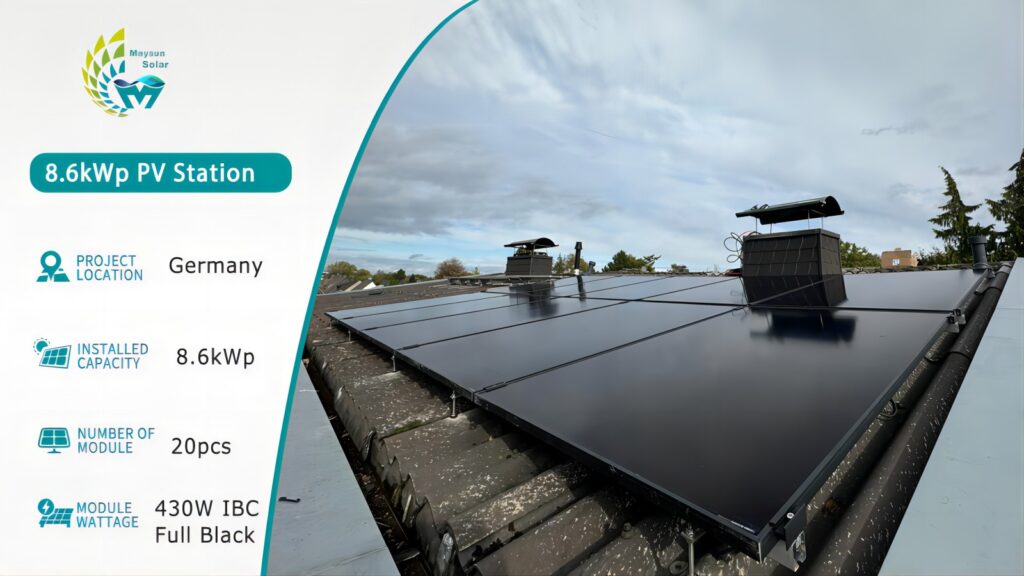
In addressing the challenge of glare pollution caused by solar panels, it is important to recognize that there are multiple complementary strategies beyond the use of low-glare solar panels. The incorporation of black solar installation accessories, including black brackets and frames for solar panels, serves a crucial role in the absorption of excess light, ultimately reducing undesirable reflections and glare. Additionally, fine-tuning the installation angle is pivotal for minimizing reflections, as it takes into account the sun’s dynamic positions throughout the day and across seasons.
Furthermore, maintaining an appropriate distance between solar panels and nearby roads emerges as a practical approach to significantly diminish the disruptive impact of glare on observers’ eyes, especially during crucial periods such as sunrise or sunset. Complementing these measures, the strategic planting of vegetation, such as short trees or shrubs, in the vicinity of solar panels can effectively absorb light and further decrease reflections.
In conclusion, when considering the installation of photovoltaic solar power stations in light-sensitive environments such as airports, highways, and residential area, careful evaluation of glare issues is paramount. Rigorous assessment and adherence to regulations, such as those set forth by aviation authorities, ensure not only the optimal functioning of solar panels but also the safety and comfort of individuals in the surrounding areas. By implementing advanced technologies like IBC solar panels with features designed specifically to minimize glare, combined with thoughtful planning regarding orientation, distance, and planting applications, we can strike a balance between harnessing solar energy efficiently and mitigating potential visual disturbances.
Maysun Solar has been specialising in producing high quality photovoltaic modules since 2008. Choose from our wide variety of full black, black frame, silver, and glass-glass solar panels that utilise half-cut, MBB, IBC, and Shingled technologies. These panels offer superior performance and stylish designs that seamlessly blend in with any building. Maysun Solar successfully established offices, warehouses, and long-term relationships with excellent installers in numerous countries! Please contact us for the latest module quotations or any PV-related inquiries. We are excited to assist you.

Empowering Factories with Solar Energy A Strategic Tool for Controlling Production Electricity Costs
Commercial and industrial solar is becoming a key solution for factories to reduce electricity costs and hedge against price fluctuations. This article systematically analyzes its deployment models, cost advantages, and sustainable value pathways.

How Businesses Can Offset Carbon Taxes with Solar Power
This article analyzes the latest carbon tax policies and photovoltaic deduction strategies, helping European businesses legally reduce taxes, increase profits through solar investment, and achieve a win-win situation for both economy and environment.

Forecast and Response: Seizing the Next Decade’s Growth Dividend in Europe’s Commercial and Industrial Photovoltaics Market
Maysun Solar analyzes the growth trends of commercial and industrial photovoltaics in Europe over the next ten years, from policies and ESG to technological innovation, helping companies seize the initiative in the energy transition.

How to Calculate Solar System ROI and Optimize Long-Term Returns?
Solar power is becoming a key solution for businesses to reduce costs and improve efficiency. Accurately calculating ROI and optimizing long-term returns are essential to maximizing investment value.

Will Agrivoltaics Affect Crop Growth?
Agrivoltaics combines solar energy and agriculture to reduce up to 700 tons of CO₂ per MW, improve water use, and boost crop growth for sustainable farming.

6.5 Billion Loss Hits Photovoltaics: Reshaping or Elimination?
In 2025, the photovoltaic market may see a turnaround as some companies take early action. A €6.5 billion loss is driving businesses to explore new growth areas like energy storage and hydrogen. Which giants will break through? Industry transformation is accelerating!

